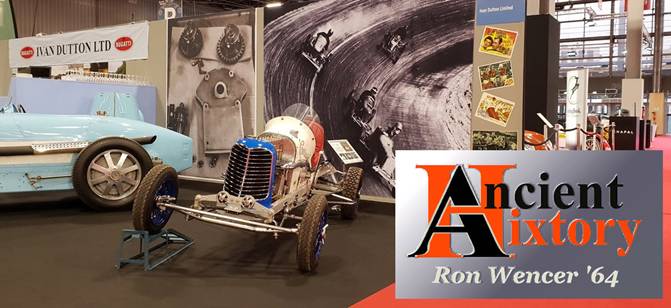
The Magic of Hicksville's Mike Caruso
Each year, connoisseurs of fine automobiles attend the Salon Rétromobile in Paris. At the 2019 Salon, Ivan Dutton Ltd exhibited five superbly restored vehicles to showcase the company's work. Four were classic Bugatti's - but the fifth was a storied Midget racer, powered by half of a Bugatti engine, and built in a salvage yard in Hicksville.
Built by Mike Caruso, its presence amidst hundreds of the world's most prized cars was a reminder of two facets of his unique legacy: his outstanding success as a builder of racing cars, and his role in the preservation of a number of classic automobiles.

Partial view of Ivan Dutton "stand" at Salon Rétromobile, Paris, February 2019
photo provided by Mark Thomas
Introduction
Who was Michael Caruso? He was a mechanic who dreamed, and who by dint of his ingenuity and dedication got to realize his dreams through auto racing, where his record as a builder/owner of cars was unprecedented. He used his junkyard on West Barclay St. in the way that alchemists supposedly used their medieval laboratories, taking worthless discards and converting them into gold. From that junkyard emerged championship racing cars, novel feats of engineering, and once-lost automobiles now of inestimable value. Caruso's legend stands on both the dirt of racing ovals and the polished floors of museums.
Let's set the stage for his story by looking at how American auto racing was changing in the 1920s, when Mike was a young garage mechanic and dreaming of his career.
Beyond Stock Car Racing
February's Ancient Hixtory noted that Americans had developed an appetite for stock car races, and could not get enough of them. Here and there, though, people had ideas about a new and different type of racing, one with cars made by individuals, not by automobile companies. The cars would be inexpensive, powerful but light, and maybe small enough to speed around the horse-racing ovals that could be found all over the country. The idea spread surprisingly quickly, and as people talked about creating home-built racers, they looked hungrily at something new in America: automotive junkyards.
Scrapyards themselves were not new. In the 1920s, however, new cars in dealers' showrooms were so much better every year that hordes of older cars, suddenly thought to be outmoded, had become the mainstay of junkyards. Among the piles of junked cars, would-be racers could find engines, parts, even chassis for the cars they wanted to build. They might even unearth useful components from some exotic source - an outboard motor, or a small airplane engine.
Although a novice hypothetically could learn a lot about building a car just by reading magazines like Popular Mechanics, an experienced mechanic had an advantage, and the sharper the mechanic's mind, the greater that advantage became.
*
Sprint Cars and Midgets
To mangle a common saying, one cannot race apples and oranges. For the sake of competition, cars in any given race have to meet common standards. The first set of standards developed for the new home-builts was for "Big Cars" (an ironic name, given that the whole idea was to make smaller cars). The races proved exciting; such cars still race today, but now are called "Sprint Cars." Subsequently, standards were developed for even smaller cars ("Midgets"). When Midgets were introduced, they quickly caught the public's fancy.
Note the attendance figures below:

Nassau Daily Review, October 30, 1935
To get an idea of the appeal of Midget racing (hyped a bit by the narrative of this British newsreel), you can use this link: https://www.youtube.com/watch?v=4yATwN7lEuU

Still from Pathé Newsreel, showing two Caruso cars racing at the Nutley, NJ Velodrome;
Bob Sall is in the No. 12 Miller, Paul Russo in No. 6 (the car exhibited in Paris years later)
youtube.com
Note that this race was run on a small banked track, constructed originally as a bicycle velodrome, rather than on the flat loose-surfaced ovals ("paved" with dirt or, less commonly, cinders) that were almost universal in the ear
Midget and Sprint races also became popular in Canada, South Africa, New Zealand, and Australia. In the U.S., interest spiked after World War II, prompting Hollywood to make movies that featured small-car racing, notably The Big Wheel with Mickey Rooney, and To Please a Lady with Clark Gable and Barbara Stanwyck.

Movie still of Clark Gable in MGM's To Please a Lady, 1950
***

